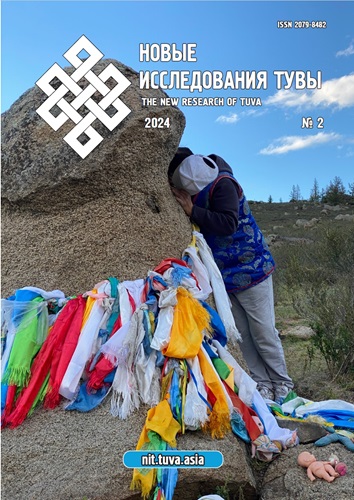Common Turkic vocabulary in the names of tools of the Yakut language (lexical parallels in the Turkic languages of Siberia)
DOI:
https://doi.org/10.25178/nit.2024.2.18Keywords:
Yakut language; Altai language; Khakass language; Tuvan language; household vocabulary; toolsAbstract
The article examines the names of tools in the Yakut language, which are of common Turkic origin, in comparison with related Altai, Khakass, and Tuvan languages. Dictionary of the Yakut language edited by E. K. Pekarsky, A large explanatory dictionary of the Yakut language in 15 volumes edited by P. A. Sleptsov, Altai-Russian Dictionary edited by A. E. Chumakaev and others, Khakass-Russian Dictionary edited by O. V. Subrakova; and the Tuvan-Russian Dictionary edited by E. R. Tenishev, were the sources for the research.
Based on the spheres of use, the author has divided the names of tools in the Yakut language into 7 categories: 1) tools for cattle breeding, 2) hunting, 3) fishing, 4) agriculture, 5) household use, 6) wood processing, and 7) leather and fur processing. It was found that many archaic words exist in the studied vocabulary, which can be associated with various changes in life and the restructuring of daily life and traditions among the Yakuts.
The study of lexical and semantic parallels between the Yakut, Altai, Khakass, and Tuvan languages through the names of tools has revealed 12 common Turkic origins, confirming the ancient kinship between these languages and their historical interactions.
References
Abdina, R. P. (2021) Nominations of Dishes and Cookware in the Khakass Language. Philology. Theory & Practice, vol. 14, no. 4, pp. 1109–1114. (In Russ.). DOI: https://doi.org/10.30853/phil210140
Antonov, N. K. (1971) Materials on the historical vocabulary of the Yakut language. Yakutsk, Yakutknigoizdat. 174 p. (In Russ.).
Böhtlingk, O. N. (1989) About the Yakut language: transl. from Germ. Novosibirsk, Nauka, Sibirskoe otdelenie. 646 p. (In Russ.).
Borisov, Yu. P. (2020) Parallels of epic formulas in the Yakut olonkho and Tuvan epic: a comparative aspect. New Research of Tuva, no. 4, pp. 250–260 (In Russ.). DOI: https://doi.org/10.25178/nit.2020.4.17
Vasil'ev, Yu. I. (2012) The Oguz component in the Yakut language (phonetic and lexical-semantic aspect). Yakutsk, Izdatel'skii dom Severo-Vostochnogo federal'nogo universiteta. 357 p. (In Russ.).
Gaffarova, F. F. (2000) Agricultural vocabulary of the Tatar language. Kazan', Dom pechati. 176 p. (In Russ.).
Grammar of the modern Yakut literary language (1982) / ed. by E. I. Ubriatova. Moscow, Nauka. Vol. 1. Fonetika i morfologiia. 469 p. (In Russ.).
Danilova, N. I. (2020) Verbal voice in Yakut and Tuvan languages in comparison with Mongolian and Tungus languages. New Research of Tuva, no. 1, pp. 143–153. (In Russ.). DOI: https://doi.org/10.25178/nit.2020.1.12
Dmitriev, N. K. (1962) The structure of the Turkic languages: selected works / ed. by E. V. Sevortian. Moscow, Izdatel'stvo vostochnoi literatury. 607 p. (In Russ.).
D'iachkovskii, F. N., Tazranova, A. R., Baiarsaikhan, B., Trofimova, S. M., Popova, N. I. (2023) Horse Gait Terms in Turkic Languages of Siberia (Compared to Mongolic Languages). Vestnik NSU. Series: History and Philology, no. 22 (2), pp. 61–73. (In Russ.). DOI: https://doi.org/10.25205/1818-7919-2023-22-2-61-73
Zykov, F. M. (1989) Traditional Yakut tools (XIX — early XX century). Novosibirsk, Nauka. Sibirskoe otdelenie. 148 p. (In Russ.).
Kaluzhinskii, S. (1961) Some issues of Mongolian loanwords in the Yakut language. In: Proceedings of the Institute of Language, Literature and History of the Yakut branch of the Siberian branch of Academy of Sciences of the USSR / ed. by E. I. Ubriatova. Yakutsk, Kn. izd-vo. Issue 3 (8), pp. 5–21. (In Russ.).
Korkina, E. I. (1970) Verb moods in the Yakut language. Moscow, Nauka. 307 p. (In Russ.).
Korkina, E. I. (1979) Verb personally related modal constructions in the Yakut language. Yakutsk, Yakutskoe knizhnoe izdatel'stvo. 104 p. (In Russ.).
Korkina, E. I. (1985) Adverbs in the Yakut language. Novosibirsk, Nauka, Sibirskoe otdelenie. 204 p. (In Russ.).
Kulakovskii, A. E. (1979) Scientific works. Yakutsk, Yakutskoe knizhnoe izdatelstvo. 494 p. (In Russ.).
Levin, G. G. (2001) Lexical and semantic parallels of the Orkhon-Turkic and Yakut languages: (in comparative terms with the Altai, Khakass, Tuvan languages). Novosibirsk, Nauka. 188 p. (In Russ.).
L'vova, S. D. (2021) Comparisons in the Yakut and Tuvan epics: general and specific. New Research of Tuva, no. 1, pp. 202–216. (In Russ.). DOI: https://doi.org/10.25178/nit.2021.1.11
Musaev, K. M. (1984) Lexicology of the Turkic languages. Moscow, Nauka. 228 p. (In Russ.).
Nikolaev, E. N. (2019) Toponyms with the Stem bas/bach in Tuvan and Yakut languages: a lingvoculturological interpretation. New Research of Tuva, no. 3, pp. 205–2014. (In Russ.). DOI: https://doi.org/10.25178/nit.2018.3.13
Popov, G. V. (1986) Words of “unknown origin” of the Yakut language: a comparative historical study. Yakutsk, Yakutskoe knizhnoe izdatel'stvo. 148 p. (In Russ.).
Prokop'eva, A. K. and Platonov, P. S. (2022) Lexico-semantic parallels of the Yakut and Altaic languages (based on the names of manual labor tools and cutting and sharpening tools). Altaistics, no. 1(4), pp. 5–14. (In Russ.).
Radlov, V. V. (1911) The experience of the dictionary of Turkic dialects. St. Petersburg, Tip. Imp. akad. nauk. Vol. 4. 2230 p. (In Russ.).
Radlov, V. V. (1887) An ethnographic review of the Turkic tribes of Southern Siberia and Dzungaria: transl. from Germ. Tomsk, Tipo-litografiia Mikhailova i Makushina. 26 p. (In Russ.).
Riasianen, M. (1955) Materials on the historical phonetics of the Turkic languages. Moscow, Izdatel'stvo inostrannoi literatury. 221 p. (In Russ.).
Seroshevskii, V. L. (1993) Yakuts. The experience of ethnographic research. 2nd ed. Moscow, Assotsiatsiia «Rossiiskaia politicheskaia entsiklopediia». 713 p. (In Russ.).
Skriabina, A. A. (2021) Obsolete household vocabulary of the Yakut language in comparison with other turkish languages (on the material of Yakut folk fairy tales). Modern Humanities Success, no. 1, pp. 188–191. (In Russ.).
Skriabina, A. A. (2022) Lexico-Semantic Parallels in the Names of Household Items of the Yakut, Khakass and Altai Languages. Philology. Theory & Practice, vol. 15, issue 10, pp. 3232–3237. (In Russ.). DOI: https://doi.org/10.30853/phil20220523
Comparative historical grammar of the Turkic languages: phonetics (1984) / ed. by E. R. Tenishev. Moscow, Nauka. 488 p. (In Russ.).
Comparative historical grammar of the Turkic languages: syntax (1986) / B. A. Serebrennikov, N. Z. Gadzhieva, ed. by E. R. Tenishev. Moscow, Nauka. 284 p. (In Russ.).
Comparative historical grammar of the Turkic languages: morphology (1988) / E. R. Tenishev, V. D. Arakin, G. F. Blagova et al. Moscow, Nauka. 560 p. (In Russ.).
Comparative historical grammar of the Turkic languages: vocabulary (1997) / E. R. Tenishev, G. F. Blagova, I. G. Dobrodomov et al.; ed. by E. R. Tenishev et al. Moscow, Nauka. 799 p. (In Russ.).
Comparative historical Grammar of the Turkic languages: regional reconstructions (2002) / E. R. Tenishev, G. F. Blagova, E. A. Grunina; ed. by E. R. Tenishev. Moscow, Nauka. 768 p. (In Russ.).
Comparative historical grammar of the Turkic languages. The Proto-Turkic language is the basis. The picture of the world of the Proto-Turkic ethnic group according to the language (2006) / ed. by E. R. Tenishev and A. V. Dybo. Moscow, Nauka. 908 p. (In Russ.).
Troshchanskii, V. F. (1903) The evolution of the black faith (shamanism) among the Yakuts. Kazan', Tipolitografiia Imperatorskogo universiteta. 216 p. (In Russ.).
Filippov, G. G. and Oorzhak B. Ch. (2020) Semantics of the secondary forms based on the participles on -byt and -gan in the Yakut and Tuvan languages. New Research of Tuva, no. 1, pp. 312–342. DOI: https://doi.org/10.25178/nit.2020.1.11
Kharitonov, L. A. (1947) Modern Yakut language. Yakutsk, Gosizdat IaASSR. Part 1: Phonetics and morphology. 313 p. (In Russ.).
Khudiakov, I. A. (1969) A brief description of the Verkhoyansk district. Leningrad, Nauka, Leningradskoe otdelenie. 437 p. (In Russ.).
Shirobokova, N. N. (2005) The relation of the Yakut language to the Turkic languages of Southern Siberia. Novosibirsk, Nauka. 272 p. (In Russ.).
Iastremskii, S. V. (1938) Grammar of the Yakut language. Moscow, Uchpedgiz. 228 p. (In Russ.).
Published
How to Cite
For citation:
Skryabina A. A. Common Turkic vocabulary in the names of tools of the Yakut language (lexical parallels in the Turkic languages of Siberia). New Research of Tuva, 2024, no. 2, pp. 300-315. (In Russ.). DOI: https://doi.org/10.25178/nit.2024.2.18
Issue
Section

This work is licensed under a Creative Commons Attribution-NonCommercial 4.0 International License.

Author(s) license holder(s) grant rights for their work to the journal (grantee of a license) under the simple non-exclusive open license in accordance with Art. 1286.1 «Open license for a research work, work of literature or fine arts», Civil Code of the Russian Federation.
New Research of Tuva publishes articles under the Creative Commons Attribution-NonCommercial license (CC BY-NC).
Since it is an open license, author(s) reserve the right to upload the article to their institutional repository, submit it to another journal (if it allows republications), or republish it on their own website (in full, or in part).
However, several conditions apply here:
a) The republished version must always contain the name(s) and affiliation(s) of the author(s), the original title and the hyperlink to the original version on the New Research of Tuva website;
b) It must be in open access, free of charge, and no category of readers must be in any way whatsoever advantaged over general readership.
c) should the contribution be submitted elsewhere by its author(s) without substantial modification (30% or more of original text unchanged), the body of the article should contain a disclaimer that the original version was published in New Research of Tuva (with a link to the respective page)
The CC-BY-NC is a non-revocable license which applies worldwide and lasts for the duration of the work’s copyright.









